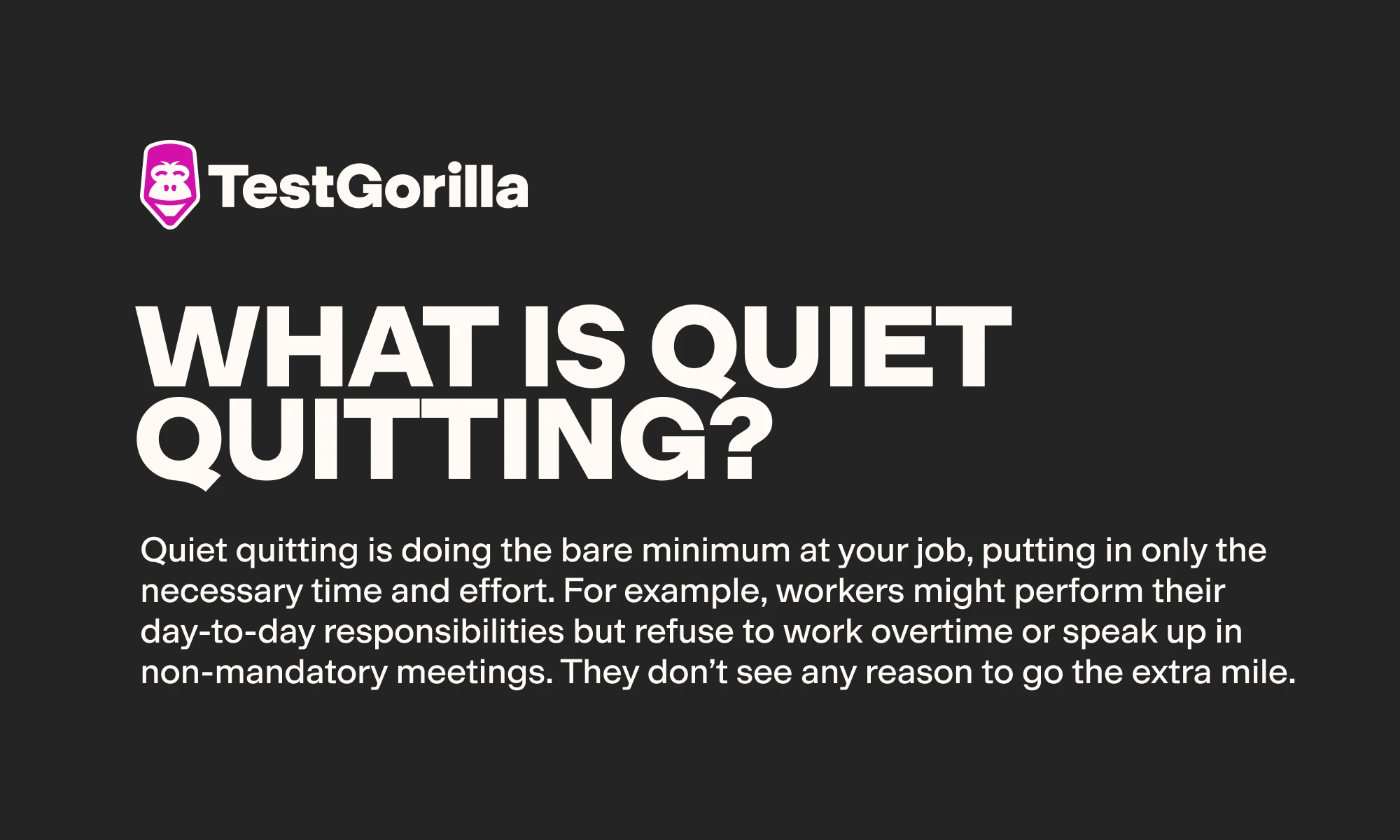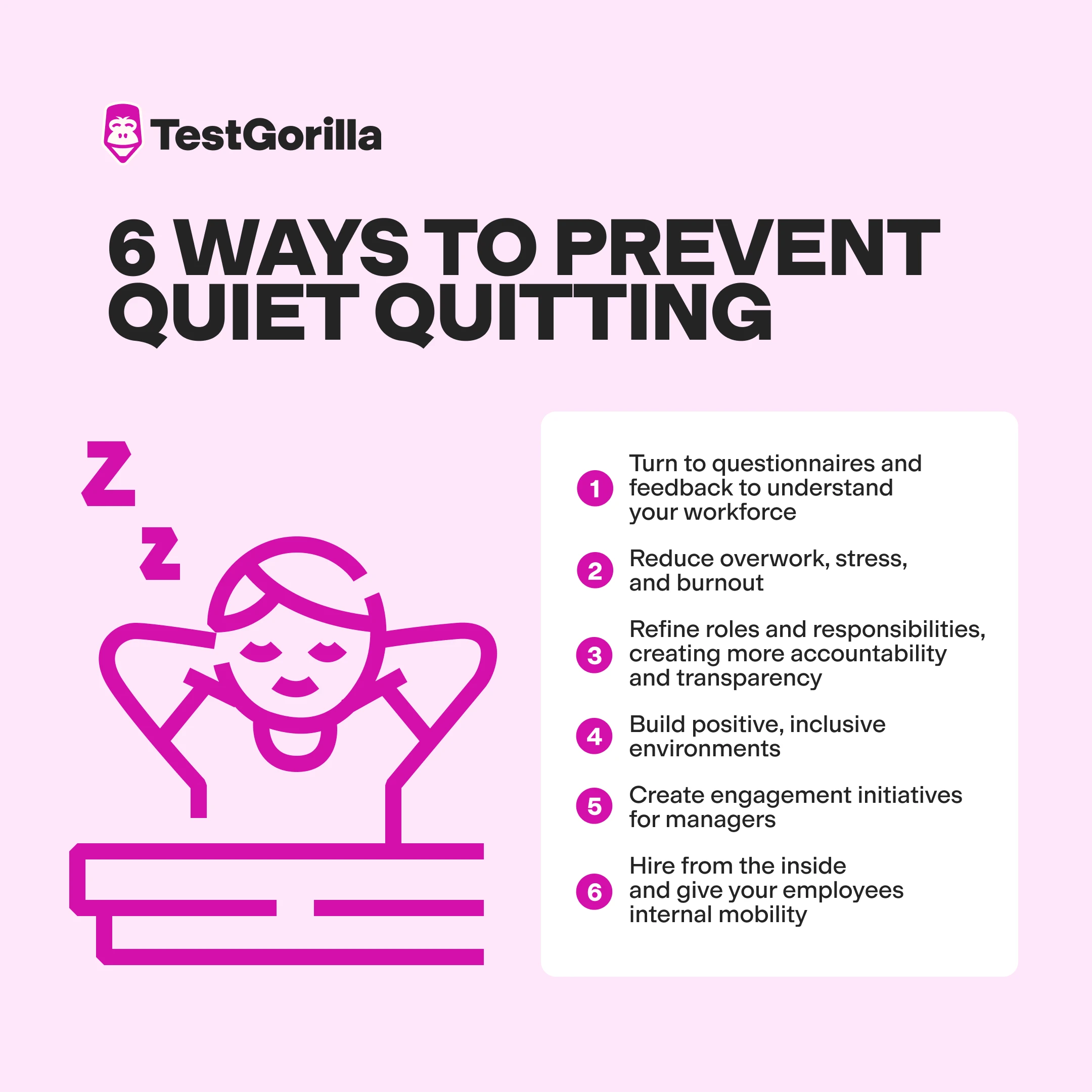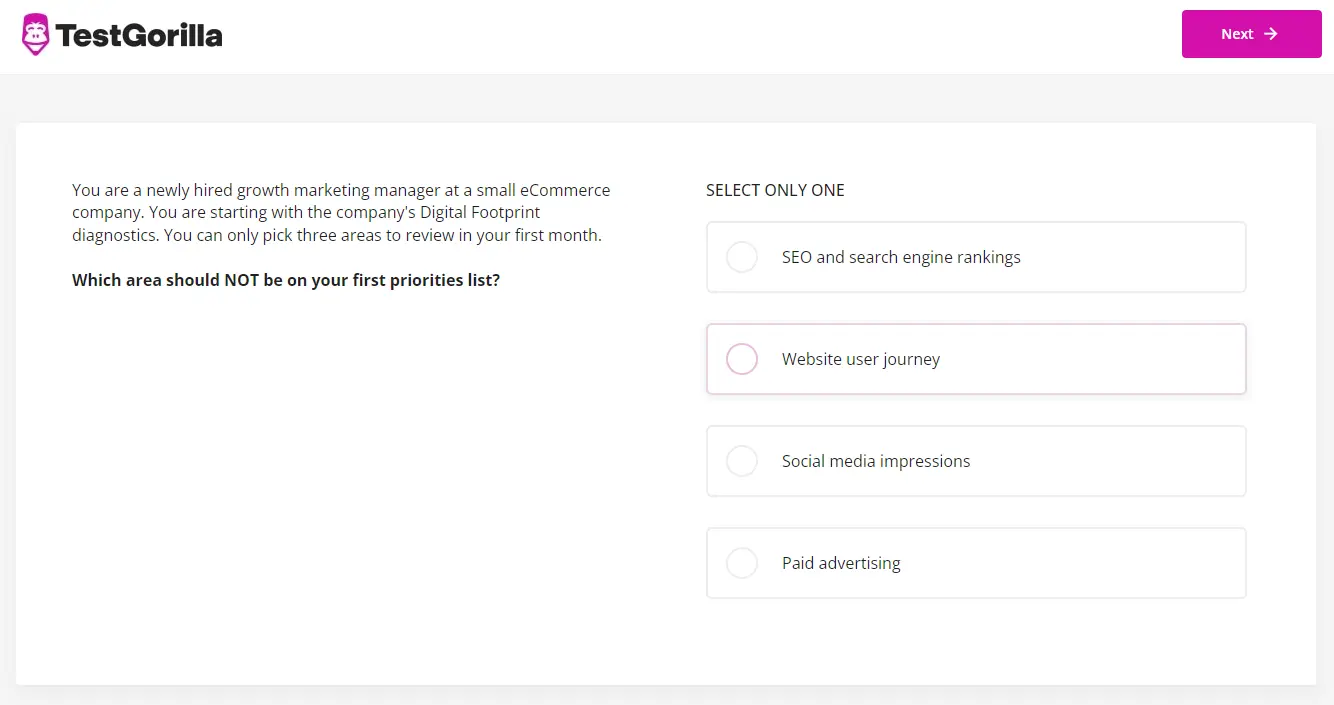Hire highly motivated employees fast
Given the current labor market shortages, knowing how to stop quiet quitting in your workforce is tough because it’s just that – quiet.
You might have the HR management skills to spot a drop in productivity, but that doesn’t mean you can identify which employees are quietly quitting or why they’re doing it.
In this article, we discuss what quiet quitting looks like and how to prevent quiet quitting in your workforce.
What is quiet quitting?
Quiet quitting is doing the bare minimum at your job, putting in only the necessary time and effort. For example, workers might perform their day-to-day responsibilities but refuse to work overtime or speak up in non-mandatory meetings. They don’t see any reason to go the extra mile.
The term “quiet quitting,” less commonly known as “soft quitting,” originated on TikTok in early 2022 in the wake of the Pandemic and the Great Resignation and spread quickly throughout social media. Workers who are tired and overpressured and feel like their job isn’t going anywhere primarily use it.
Most workers who popularized the phrase “quiet quitting” are either Gen Z or millennials, and data supports that those generations are indeed more likely to engage in this behavior.
A survey found that 82% of America’s Gen Z workers find quiet quitting extremely appealing. The new trend of Gen Z quiet quitting is likely due to stress and burnout, as Gallup research shows that Gen Z workers experience more stress than workers over 40. Although some economists may say some older workers may also be experiencing the same phenomenon, they tend to use different terminology, such as “dissatisfaction” or “retiring in post.”
Is the quiet quitting trend real?
Quitting statistics show that the quiet quitting trend is undoubtedly real. Gallup found that at least 50% of the American workforce describes themselves as quiet quitters.
Another study found that about one in six workers is completely disengaged, and only one in three workers is actively engaged.
Of course, a common argument is that quiet quitting is simply a new name for an old problem. Some say that this is just worker dissatisfaction under a different guise.
Either way – whether it’s a brand-new phenomenon or a new way to describe an older issue – we believe the quiet quitting trend is important because it brings serious issues to light.
The best insights on HR and recruitment, delivered to your inbox.
Biweekly updates. No spam. Unsubscribe any time.
Examples of quiet quitting: 3 real-life case studies
Examples of quiet quitting behaviors look different depending on the role at hand. For many office jobs, they may include things like not taking part in group discussions or non-mandatory meetings or refusing to participate in team celebrations.
Here are three real-life case studies of quiet quitting at work:
A Vice journalist suffering from burnout decided to test out quiet quitting by only doing work required by a deadline or that a colleague requested over Slack or by email. He halved his usual weekly work time from 40 hours to 20.
One research study of nurses found that 77.3% quit quietly, with 80.2% working in understaffed departments. This quiet quitting meant they did not suggest new ideas, stay overtime, or arrive at work early. A similar study in the International Nursing Review found that this quiet quitting trend was higher among nurses than physicians and other healthcare workers.
A teacher started quiet quitting after not receiving an adequate pay raise and witnessing favoritism from senior management. Instead of searching for a new job, he opted to do “minimum work” in his current role, which meant stopping publishing papers and attending conferences.
Each of these examples shows the core reasons for quiet quitting: overwork and burnout, a lack of career progression, and feeling undervalued by management.
How to prevent quiet quitting: 6 ways
If you want to move your organization beyond quiet quitting without layoffs, try these six strategies to re-engage your workforce.
1. Turn to questionnaires and feedback to understand your workforce
The first thing to establish is whether your workforce is quitting quietly.
We recommend sending questionnaires and pulse surveys to gather valuable insights and feedback. These can help you better understand the current situation and lead you toward a solid solution.
For example, your survey might discover that your low engagement stems from tight work deadlines, but if you review the feedback in detail, you can work toward a solution, such as spacing the deadlines more evenly.
Here are some example questionnaire questions:
How do you feel about work today?
Do you feel excited about working here?
Do you feel like your work is recognized?
Does our company culture foster a supportive environment?
What do we need to change to improve your work environment?
Listen to this feedback, implement the suggestions, and let your employees know you used their ideas.
Acting on your workforce’s suggestions is a great practice that boosts employee morale, motivation, and company loyalty.
There are several effective ways to announce implemented feedback, such as:
One-on-one meetings
Weekly huddles
Periodic “town hall” meetings specifically for announcing feedback
A Slack channel for discussing feedback
Surveys and questionnaires help you build an organization that combats quiet quitting and puts people first.
2. Reduce overwork, stress, and burnout
The World Health Organization now officially recognizes burnout as an occupational phenomenon. Burnout, a result of poor work-life balance, causes exhaustion, depression, anxiety, and feelings of detachment, so it’s no wonder that it also causes quiet quitting.
For example, a consultant working more than 60 hours per week in a hustle culture job decides the bare minimum is all he can give after seeing the consequences of that lifestyle.
Likewise, a sales rep returns after a two-day vacation to see that she still has to meet her quota – counting those two days off.
Unrealistic expectations destroy morale and motivation, leading to disengagement. Reducing burnout in your organization is crucial in minimizing quiet quitting.
Here are some of our top recommendations for mitigating overwork and burnout:
Build a positive company culture – discourage toxic behavior and promote timely recognition
Encourage mental health breaks and time off – ensure employees take time off for their wellbeing and destigmatize mental health breaks
Consider implementing alternative working arrangements – empower employees to get work done when they’re most energetic by offering flexible or remote work
Be more mindful of employee workloads – downplay the importance of multitasking, and keep an eye on overflowing workloads
For our in-depth guide on the subject, read our blog post on employee burnout.
3. Refine roles and responsibilities, creating more accountability and transparency
A clearly defined job description, roles, and responsibilities greatly impact quiet quitting and your business as a whole.
People need to see how they contribute individually to the organization’s overall goals; otherwise, they don’t develop employee relationships and feel like a tiny cog in a giant machine, which isn’t motivating or engaging.
Clear roles and responsibilities also prevent employees from taking on responsibilities that aren’t theirs. A lot of quiet quitting occurs because workers do tasks simply so that they get done, regardless of whether they’re part of their job.
For example, a project manager might stay late to finish messaging a handful of clients even though that’s the account manager’s responsibility.
Sticking to your job duties greatly reduces stress and quiet quitting and is key to setting boundaries at work.
Refining your job roles also benefits your hiring initiative. Knowing which skills and responsibilities are relevant to each role before you start hiring means that you can quickly put together relevant talent assessments for each role.
These enable you to test candidates only on directly relevant skills.
For example, if you define the responsibilities of your marketing team before hiring a junior marketer and a senior marketer, you may decide that only the senior marketer needs B2C Growth Marketing skills because this is not listed in the junior marketer’s responsibilities.
Our B2C Growth Marketing test looks at candidates’ ability to diagnose growth barriers and develop and implement growth plans, for instance:
For more questions from this test, visit the B2C Growth Marketing test preview.
The results could be transformative. According to our research, 82% of organizations reduced their time-to-hire after switching to skills testing, with nearly a third of employers reducing it by an average of 18%.
One example is ExoGroup, which switched to TestGorilla and not only streamlined candidate screening but boosted engagement throughout the recruitment process.
4. Build positive, inclusive environments
Negative environments play a major role in quiet quitting. Employees don’t put extra effort into a toxic workplace and cannot properly connect and engage with the company.
For example, a worker facing discrimination daily decides to keep their head down, avoid extra work, do the bare minimum, and get out. They adopt the approach of ruffling no feathers and simply getting a paycheck.
You can help by discouraging toxic behavior, discrimination, and biases and building a more positive workplace. Do this by:
Encouraging positive communication: Promote an open-door policy and practice nonviolent communication
Building a culture of recognition: Appreciate and recognize employees frequently and promptly
Offering accommodations: Provide accommodations for your workers, such as a quiet workspace for neurodivergent employees or flexible work for working parents
Reducing bias with skills-based hiring: Hire employees based on talent and capability, and reduce unconscious bias in the recruiting process
Unconscious bias affects employers in ways they may never expect and can include preconceived notions about candidates based on age, race, gender, hometown, and even name.
Switching to skills-based hiring enables you to create an inclusive culture from day one.
You can also use skills tests such as the Culture Add test to hire people who align with your company.
Once you build an inclusive, positive organization, you can hire like-minded people with fewer toxic behaviors and higher empathy to help employees move beyond quiet quitting into quiet thriving.
Hire quiet thrivers with effective skills testing.
Explore our test library to find your next top recruit.
5. Create engagement initiatives for managers
When combatting quiet quitting in your workforce, it’s important to pay particular attention to managers. If a manager is quietly quitting, this could affect productivity, happiness, and even turnover in their team.
Likewise, a bad manager can provoke quiet quitting in their team by:
Bullying or discriminating against workers
Micromanaging or creating a psychologically unsafe atmosphere
Talent hoarding and blocking opportunities for their team members to progress
Overworking co-workers and creating poor boundaries
“Quiet firing” employees by giving them fewer tasks
It’s, therefore, important to ensure that managers are engaged with their work and invested in creating a healthy environment for their direct reports.
It’s also important to secure managers’ buy-in when designing employee engagement initiatives for their direct reports. If they understand and agree with what you’re asking them to do, they’re more likely to engage with it and follow through.
It starts with ensuring all managers – and employees more generally – have strong compensation and benefits, including paid time off that they are encouraged to use.
Senior leaders should model healthy work boundaries for managers, for example, not sending emails outside of work hours or expecting managers to work unpaid overtime.
You can also push forward other engagement initiatives, including:
Incorporating teams’ skill development and wellbeing into managers’ recognition and rewards programs – for example, offering managers a bonus for consistently high team satisfaction scores
Creating a mentorship program specifically for managers to receive coaching from higher-ups
Providing extensive training on how to be a good manager and encouraging them to develop their unique leadership style
6. Hire from the inside and give your employees internal mobility
Many people try quietly quitting because they feel their careers have stalled. It can be even worse when every good role gets filled by external candidates when they’re sitting right there.
Internal mobility motivates and engages employees by showing them they’re valuable to the organization. It’s no wonder that one LinkedIn study found businesses that excel at internal mobility retain employees twice as long.
You can facilitate this process by having an excellent internal talent marketplace – a space where you can post open roles, and employees can apply for them directly in your system.
Such a space promotes the opposite of quiet quitting: quiet hiring when your organization constantly looks for strong internal and external candidates and opportunities they could seize at your organization.
You should also provide employees with tangible career support.
Ask about employees’ aspirations and goals during regular one-on-one meetings. You can suggest roles they’d be suited to or skills they should develop.
Using these meetings as a jumping-off point, help your people create professional development plans (PDPs).
Encourage employees to use PDPs within your business to help them set goals and create strategies for achieving them.
You can even use employees’ scores on skills tests to identify areas for potential growth. For example, if an employee expressed an interest in becoming a manager, you could:
Test their leadership skills to see what skills they’re working with
Assign leadership training appropriate to their skill level
Retest their leadership skills to see how they’ve improved
Enter this data into your internal talent marketplace
Include further training and promotion opportunities in their PDP
This practice can prevent both quiet quitting and actual quitting, reducing employee turnover as a whole.
Level up your workforce’s skills.
Find out how our skills tests can help target your learning and development initiatives.
Use skills tests to build a workforce without quiet quitting
In this article, we have covered:
The definition of quiet quitting
Quiet quitting statistics and why it happens
Examples of quiet quitting in action
How to prevent quiet quitting in your workplace
The next step is to hire motivated employees who add to your company culture – and only you can do that.
Get started by taking a product tour of TestGorilla.
To find out how our tests could help engage your workforce, book a demo with us today.
If you’re ready to get started, sign up for our Free forever plan.
Quiet Quitting FAQs
If you still have questions about the quiet quitting trend, don’t worry – here are our answers to some common queries.
What is causing quiet quitting?
The primary causes of quiet quitting in the workplace are stress, burnout, and a lack of appreciation caused by poor management. When these factors combine, employees feel that it is not worth working hard to keep up with an unmanageable workload when their bosses don’t appreciate their efforts.
How to tell if someone is quiet quitting?
Not speaking up in non-mandatory meetings
Not participating in team-building exercises and events
No longer suggesting new ideas or initiatives
Stopping any “extra” work, such as attending conferences or publishing papers
Starting work late or leaving work early on a regular basis
Why is quiet quitting bad for employees?
Quiet quitting is bad for employees because if you disengage from your work and seem to be coasting, your colleagues and managers may assume that you are uninterested or incompetent. Not only could this cut you off from exciting opportunities at your company, but it could also lead to your dismissal or struggle to secure good references for a new role.
You've scrolled this far
Why not try TestGorilla for free, and see what happens when you put skills first.
























